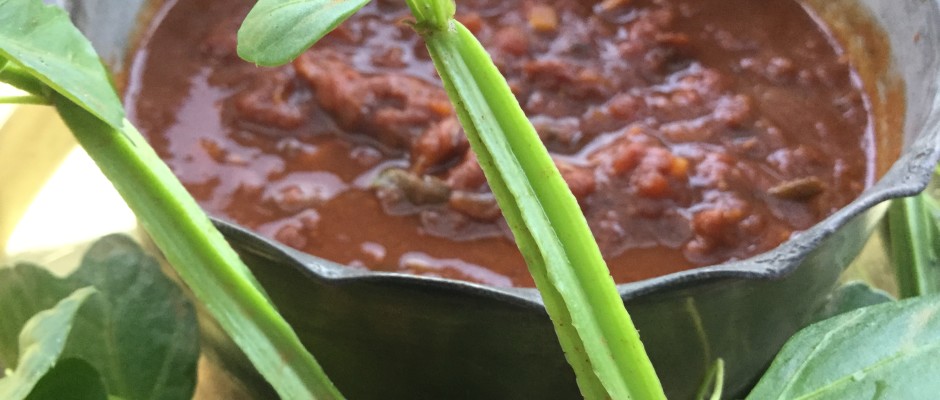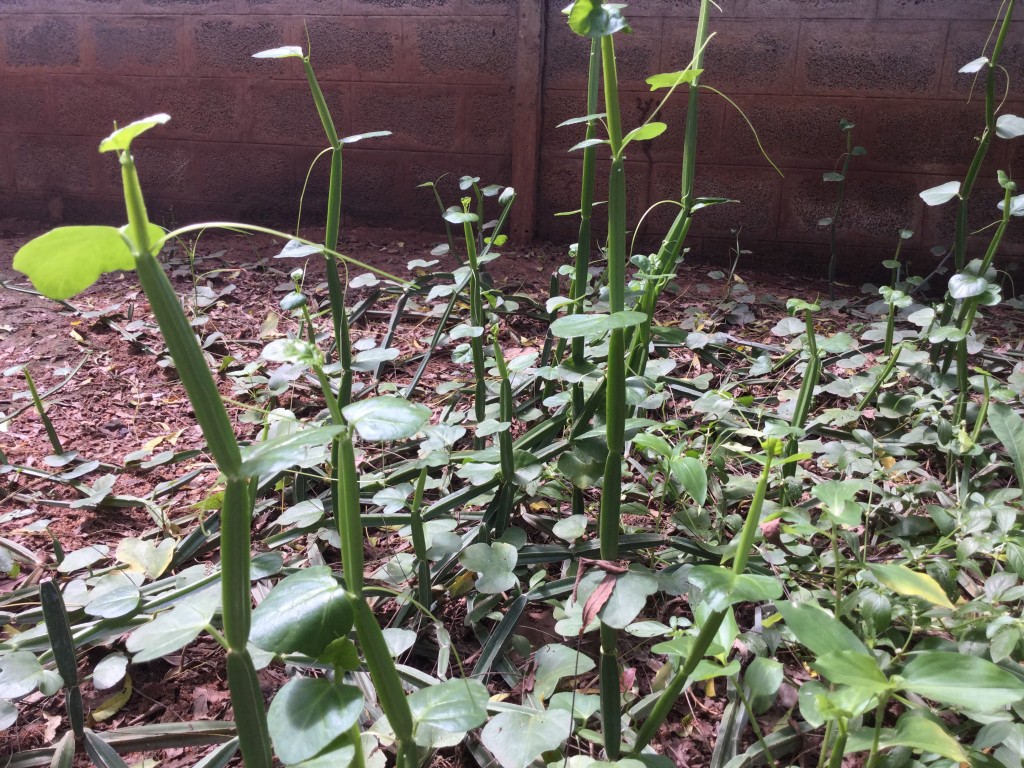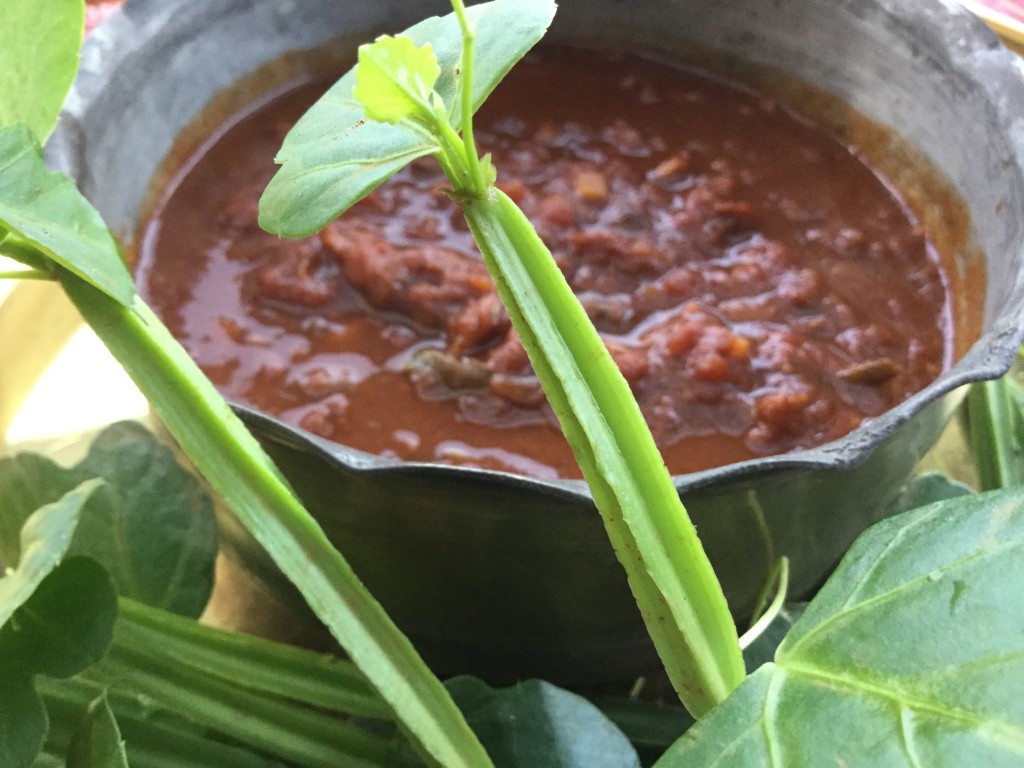Hindu metro plus , Pirandai chronicles
During the Kovai vizha last year I visited the food exhibition set up by the Kovai foodies group. They had showcased traditional kongu food. While I recognized most of the items on display , there was one name that was completely alien to me . I had never before heard , tasted or seen what they referred to ,colloquially as “perandhae” . Divya was with me during this visit and she mentioned that it was a part of her childhood diet. The correct name is Pirandai. It is not really one of those ingredients that one comes across in the supermarkets.
Of course I was fascinated and promptly mentioned it to my grandmother the next day. She listened to me patiently with a smile before pointing me in the direction of her kitchen garden. Imagine my surprise when I saw a nice big patch of the ‘never before seen or heard of vegetable growing right in her backyard, all this time . Seeing my interest, kindly old Appu- the cook of several decades,immediately offered to snip a few segments for me to plant in my garden at home.
I carried it back carefully and planted it in a spot that received medium sunlight. Less than a year later, I have not one but two thriving pirandai patches. In English it is also known as ‘Adamant creeper’ and I can see why. It is an extremely hardy plant. It grows rather quickly and the tendrils though tiny have a very firm grip on the ground as well as any other plant or tree in the vicinity. Though the folk here refer to it as a ‘keerai’ ,it’s very different from what we would think of as spinach. For one ,the leaves aren’t used for cooking. It’s the stem like part that grow into many node like long pieces which are used for cooking.
The first time we made it was in a simple tamarind gravy using dried red chillies , saunf , garlic , turmeric powder and salt. Once cooked, this hard rod like vegetable almost melted in the mouth and was delicious. The second time we made it however , a few people who ate it complained of itchiness on the tongue. It made me wonder if this was one of those ingredients that many people could be allergic to. As luck would have it , I happened to mention it in the course of conversation to an elderly relative and there I got the answer to the probable cause for the itch factor.
Apparently , those who are used to cooking with the pirandai know that while cutting it , one must stop with the third segment from the top. It’s the top two or three segments that are meant for cooking. Only the most tender young pods are meant to be eaten. If we pluck the lower segments it could set off this kind of unpleasant itchy sensation. Again , I was amazed by the wealth of information that our elders possess in their memory banks !
There on we made sure to go by that rule of plucking and no one has complained of the same problem since. It does however cause the fingers and palms to turn a bit red and feel scratchy while picking and handling. The reason being the outer portion has ribbed edges that are quite raspy to the touch. To prevent this from happening a smear of sesame oil on the palms beforehand is a good remedy. Before cooking,these outer edges must be trimmed off with a sharp knife. It can then be sliced down the middle before being chopped into smaller sizes as warranted by the recipe .
Pirandai is an ingredient that can be used in many ways. It’s just as delicious in a chutney or can even be made into a pickle. In the past ,children living in smaller hamlets were given the famous kallidaikurichi appalams. These were much sought after for their unique taste which was due to the addition of the pirandai juice. Sadly now although the appalam is still made in this small town ( Kallidaikuruchi) in Tiruchirapalli , it is done so without adding this healthy liquid ! Also referred to as Veldt grape, the pirandai has many medicinal benefits. It is used in Ayurvedic medicine for stomach disorders and even as a poultice for sprains.
Pirandai chutney is quite intense and a little goes a long way . In our home ,the chutney is the easisest way of getting this special nutrient into my kids’ stomachs. It’s also the perfect idli/dosa accompaniment to counteract the chill of a November morning!
Pirandai chutney
Heat a little sesame oil and add asafoetida. Fry dried red chillies, urad dal and sesame seeds. Set aside. In the same oil, fry the washed and cut pirandai pieces until soft. Blend together with tamarind, salt, a bit of jaggery and water.
It must be eaten in moderation. Twice a week is ideal for getting the required nutrition. In excess, it can cause burning or discomfort.




I am a resident of bangalore. Kindly let me know whether it will be possible for me to obtain pirandai creeper from you
to cultivate in my garden? If possible kindly let me know the price .
Thanks
Regards
Sitaraman ganesh
Good afternoon Mr.Sitaraman.I live in Coimbatore and would be happy to give you a few cuttings from my pirandai patch.I cannot accept payment because we don’t do these kind of commercial selling. Do mail me your number and I shall get in touch 🙂
My MIL made Pirandai thovayal. I happened to eat a small bit of Pirandai in the thovayal. Immediately, after eating, I started having burning sensation in my mouth, tongue and throat as well. How can I reduce the burning sensation?
Hi Padmatharani.Oh I’m sorry to hear that. To my knowledge,when cutting the pirandai it is important to only cut the top 3 segments. anything too close to the base of the plant may generally give an itching sensation in the mouth.Your reaction seems more extreme. Was the pirandai bought or from your own garden ?
U need to fry perandai properly otherwise it’ll start itching from mouth till throat
Perandai is best medicine for bone fractures and joint pains. U need to add tamarind compulsory to avoid itching.
Hi ! Thank you. Will keep that in mind as well. We generally pick the top 3 segments only to avoid getting an itchy throat. We usually add tamarind too. However will make sure of it even more now. 🙂